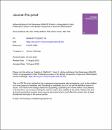Alpha-methylacyl-CoA Racemase (AMACR) Protein is Upregulated in Early Proliferative Lesions of the Breast Irrespective of Apocrine Differentiation
| Author | Zoran, Gatalica |
| Author | Stafford, Phillip |
| Author | Vranic, Semir |
| Available date | 2022-08-25T07:22:29Z |
| Publication Date | 2022-08-21 |
| Publication Name | Human Pathology |
| Identifier | http://dx.doi.org/10.1016/j.humpath.2022.08.002 |
| Citation | Gatalica Z, Stafford P, Vranic S, Alpha-methylacyl-CoA Racemase (AMACR) Protein is Upregulated in Early Proliferative Lesions of the Breast Irrespective of Apocrine Differentiation, Human Pathology, https://doi.org/10.1016/j.humpath.2022.08.002. |
| ISSN | 00468177 |
| Abstract | Alpha-methylacyl-CoA racemase (AMACR/P504S) is a mitochondrial and peroxisomal enzyme involved in the branched-chain fatty acid and bile acid metabolism. AMACR is a useful diagnostic biomarker for prostate carcinomas and several other malignancies. Its expression in apocrine breast lesions had been previously reported, but its role in breast cancer progression has not been fully investigated. One hundred fifty breast samples (80 with invasive carcinomas) were studied. The expression of AMACR protein was analyzed using the immunohistochemical method (IHC). Lesions were considered positive if AMACR was detected in ≥10% of the cells at any intensity comprising a histologically defined normal epithelial structure or a pathologic lesion. In addition, AMACR mRNA relative expression was calculated from the whole-transcript RNA-Seq performed on >20,000 diverse tumor samples using a 20,000+ hybrid-capture NGS assay with the transcript capture panel based on the Agilent SureSelect Human All ExonV7. Expression of AMACR protein was restricted to epithelia. It was uncommon in the normal breast (7/81 samples, 9%). Increasing AMACR expression was observed with proliferative epithelial lesions (18% of usual ductal hyperplasias/adenosis, 70% of atypical lesions and 72% of DCIS/LCIS). Invasive ductal carcinomas NST and invasive lobular carcinomas expressed AMACR in 64% and 46%, respectively. The highest AMACR expression was observed in luminal B and HER2-positive breast carcinomas (86-100%). Triple-negative breast carcinomas exhibited AMACR in 50% of the cases. Apocrine lesions showed strong, nearly uniform overexpression of AMACR (100% of metaplasias, hyperplasias and in situ carcinomas and 88% of invasive apocrine carcinomas were positive). RNA-Seq analysis also confirmed AMACR expression in breast carcinomas, although its median value was substantially lower with a lower standard deviation than in prostate carcinomas. Over-expression of AMACR characterizes various proliferative, preinvasive and invasive breast lesions and is not specific to the apocrine morphology. It points to altered lipid metabolism (branched fatty acids) as one of the general characteristics of breast carcinogenesis, like several other malignancies. Its early detection may represent a potential target for cancer progression intervention. |
| Sponsor | Open access funding of this article was provided by the Qatar National Library (QNL). |
| Language | en |
| Publisher | Elsevier |
| Subject | Breast breast carcinoma proliferative lesions apocrine lesions AMACR Immunohistochemistry-lipidomics |
| Type | Other |
| Open Access user License | http://creativecommons.org/licenses/by/4.0/ |
| ESSN | 1532-8392 |
Check access options
Files in this item
This item appears in the following Collection(s)
-
Medicine Research [1297 items ]



